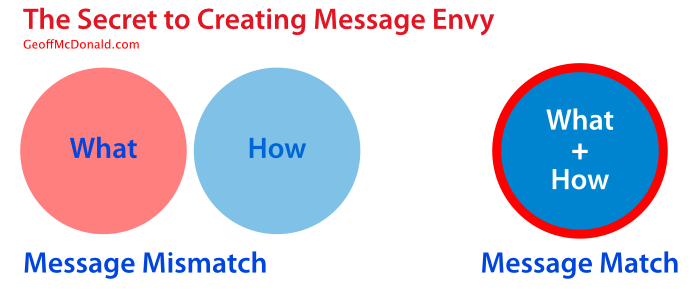
Message Envy
As the Ideas Architect I spend a lot of time looking at the communication of ideas. You could say I’m obsessed. I’m constantly checking out signs, advertising, labels, book covers, blogs and more to see what and how they organize and share their message. Mostly, I’m highly critical. I don’t mean negative, I mean judgmental. I’m constantly assessing, reviewing and re-designing the messages I see. And, every now and then I’m hit with a big dose of message envy. It’s when I see something that is so good that I wish I’d created it. It’s not a serious illness and mostly it inspires me to keep improving the quality of my work.
The Problem
The biggest problem with most messages is when they present a mismatch. A message mismatch is when the words or surface message say one thing and the underlying structure says something else. It’s just like when someone lies to you… the words say one thing and the tone or body posture say something else.
[Tweet “The biggest problem with most messages is when they present a mismatch of what and how”]
Mismatch Examples
Here’s three examples of a message mismatch that I’ve encountered recently:
- A book called Brief: Make a bigger impact by saying less that is 217 pages in length and filled with text like most other business books.
- A leadership organization where the CEO micromanages the final edit of a piece of non-strategic content.
- Fruit juice advertised as fat-free. Walk down any supermarket aisle and you’ll see a bunch of similar mismatched messages. Many of these messages are deliberately mismatched or plain misleading. And if you know how to construct a message you can see through the mis-information more easily.
Message Alignment
Instead of a mismatch you want to align and overlap your message. And, to achieve this you need think about both the ‘what’ and the ‘how’ of your message. Usually we’re clear on the ‘what’ because we’re so focused on the words or the content of our message. This is typical for most presenters. We write a whole bunch of words down and then stand up and talk. To create a greater impact for your message instead of simply saying it, you also need to demonstrate it. This is the ‘how’. We want the ‘how’ to reinforce the ‘what’.
Alignment Examples
Here’s some examples of message alignment:
- An environmental consultant can easily demonstrate their conviction by printing on recycled card.
- If you’re writing a book about making a bigger impact by saying less then… say less! Don’t just talk about it – show us how to do it! Use diagrams, use bullet points, use graphs and most importantly edit your words down to an absolute minimum.
- For presenters the key is to think about the emotion underpinning your message. For instance, if you’re presenting about creativity then don’t just talk about it. Instead, stimulate the experience of being curious, playful and self-expressed.
- Hopefully, the two diagrams on this page demonstrate what I’m talking about with mismatch and alignment. Make your message have more impact by presenting it with more impact!
Love to hear your thoughts about this and any other examples you have about message mismatch.



